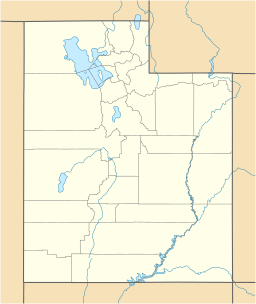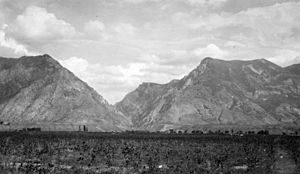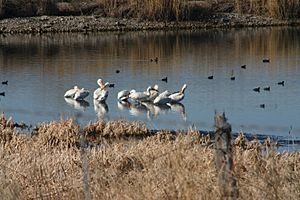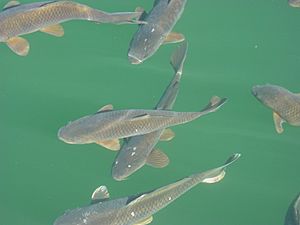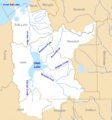Utah Lake facts for kids
Quick facts for kids Utah Lake |
|
|---|---|
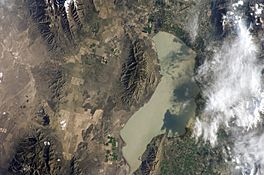
Satellite photo of Utah Lake
|
|
| Location | Utah County, Utah, United States |
| Coordinates | 40°13′12″N 111°48′00″W / 40.22000°N 111.80000°W |
| Type | slightly saline Eutrophic |
| Primary inflows | American Fork, Provo River, Hobble Creek, and Spanish Fork |
| Primary outflows | Jordan River and evaporation |
| Catchment area | 3,846 sq mi (9,960 km2) |
| Basin countries | United States |
| Managing agency | State of Utah |
| Max. length | 24 mi (39 km) |
| Max. width | 13 mi (21 km) |
| Surface area | 95,000 acres (380 km2) |
| Average depth | 10.5 ft (3.2 m) |
| Max. depth | 14 ft (4.3 m) |
| Water volume | 870,000 acre⋅ft (1.07×109 m3) |
| Surface elevation | 4,489 ft (1,368 m) (compromise) |
| Islands | 1 |
| Settlements | Provo-Orem metropolitan area |
Utah Lake is a large, shallow freshwater lake in the middle of Utah County, Utah, United States. It sits in Utah Valley, surrounded by the cities of Provo and Orem. The lake's only way for water to leave is through the Jordan River, which flows into the Great Salt Lake. A lot of its water (42%) simply evaporates, which makes the lake a little bit salty. The lake is about 4,489 feet (1,368 m) above sea level. If the water level gets too high, special pumps and gates on the Jordan River are opened to let water out.
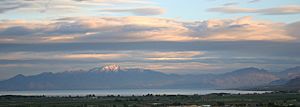
The first European to see Utah Lake was Father Silvestre Vélez de Escalante in 1776. He stayed with the Timpanogots, a group of the Ute Tribe, for three days. Later, between the 1850s and 1870s, the Timpanogots either joined the Mormon settlers or were moved from the area.
Sadly, the native fish in the lake were caught too much by the settlers. Because of this, new types of fish were brought in. Out of thirteen native fish species, only the Utah sucker and the very rare June sucker are left. The most common fish now is the common carp, which was brought in 1883. Carp make up about 90% of all the living things in the lake. They cause problems for native fish by changing the lake's environment.
Pollution has also harmed the lake. Dirty water was released into the lake as late as 1967. Even today, the lake has too much phosphorus and mineral salts, which goes against the Clean Water Act. In recent years, the lake has often had harmful algae blooms.
Utah Lake is looked after by two groups: the Utah Division of Forestry, Fire & State Lands and the Utah Lake Commission. The Division handles public use and permits for businesses. The Commission helps with planning and development around the lake. The land under the lake and its shoreline belongs to the State of Utah.
Contents
Exploring Utah Lake's Location
Utah Lake is located in Utah Valley, in the north-central part of Utah. Mountains surround Utah Valley on three sides. The Wasatch Range is to the east, the Traverse Mountains to the north, and the Lake Mountains to the west. Mount Nebo is very tall at 11,863 feet (3,616 m), and Mount Timpanogos is 11,745 feet (3,580 m) high. These mountains are nearly 7,250 feet (2,210 m) above the valley floor.
A mountain called West Mountain, which is 6,805 feet (2,074 m) tall, sticks into the south part of the lake. It separates Goshen Bay and Lincoln Beach. Utah Lake is on the western side of the valley and covers more than 25% of the Utah Valley floor. The eastern shore of the lake slopes gently, while the western shore rises steeply against the Lake Mountains.
Two large, shallow areas are connected to the main lake. These are Goshen Bay to the south and Provo Bay to the east. Big cities like Provo and Orem are located between the lake's eastern shore and the Wasatch Range.
How Utah Lake Was Formed
Utah Lake is what's left of a much bigger ancient lake called Lake Bonneville. This huge lake existed from about 75,000 to 8,000 years ago. At its biggest, about 30,000 years ago, Lake Bonneville was 5,090 feet (1,550 m) above sea level. It covered an area of 19,800 square miles (51,000 km2), almost as big as Lake Michigan.
Around 12,000 years ago, the weather in the area became warmer and drier. More water evaporated than flowed in, so the lake started to shrink. This left behind Utah Lake, the Great Salt Lake, Sevier Lake, and Rush Lake.
Why Utah Lake is Shallow
Over the 65,000 years that Lake Bonneville existed, layers of mud and sand built up. This created a flat plain over Utah Valley. Because of this, the valley floor and the lake bed are quite flat. This is why Utah Lake is so shallow.
The lake is only about 14 feet (4.3 m) deep at its deepest point. Its average depth is about 10.5 feet (3.2 m). Because it's so shallow, winds can easily stir up the mud from the bottom. This makes the water cloudy, which can look like pollution.
Hot Springs and Bird Island
Three faults (cracks in the Earth's crust) run under Utah Lake. One of them, the Bird Island fault, is under the eastern edge of the lake. It helps create hot springs near Lincoln Beach. Another big hot spring is on the northern shore, called Saratoga Springs. These hot springs happen because of water pressure as groundwater flows towards the middle of the lake.
The lake has a small island called Bird Island. It's about 2.25 miles (3.62 km) north of the Lincoln Beach boat ramp. The island has a few trees and can be seen from Lincoln Beach. When the water level is high, the island might be completely underwater, with only the trees showing. It's a popular spot for people who like to fish for walleye, white bass, and channel catfish.
How Water Flows in Utah Lake
The area that drains into Utah Lake is called its watershed. This watershed covers 3,846 square miles (9,960 km2) of mostly mountainous land. The highest point in this area is Bald Mountain in the Uinta Mountains, at 11,765 feet (3,586 m).
Two main rivers bring almost 60% of the water into Utah Lake. The Provo River brings 36% of the water, and the Spanish Fork river brings 24%. Other rivers and creeks that flow into the lake include the American Fork river, Current Creek, Dry Creek, Hobble Creek, and Mill Race Creek. Many hot springs and smaller creeks also add water.
Utah Lake drains into the Jordan River, which starts at the north end of the lake. The Jordan River flows north through Utah, Salt Lake, and Davis counties, and then into the southeast part of the Great Salt Lake. Because the area is dry, the lake has a large surface, and it's shallow, a lot of water (42%) leaves Utah Lake by evaporating into the air.
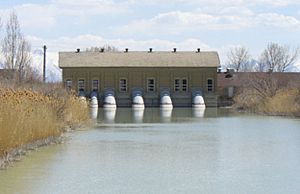
After several years of dry weather, companies that used water for irrigation argued about their share of Utah Lake's water from the Jordan River. In 1901, a judge made a decision called the Morse Decree. This decision said that these companies could use the Jordan River's water for cities, farms, and homes. It also said they could store all the river's water in Utah Lake.
Because of this, a large pumping plant was built at the start of the Jordan River from Utah Lake. It was the biggest pumping plant in the United States at that time. The plant had seven pumps that could move a lot of water. After this decision, Utah Lake became like a big water storage tank for irrigation, and the Jordan River's flow was carefully controlled.
In 1985, a new agreement was made about the lake's maximum water level. This new level was set at 4,489 feet (1,368 m) above sea level. When the water in Utah Lake goes above this level, the Jordan River pumps and gates are opened to let water out. This new level also meant that the lake's surface was lower than the Jordan River's streambed.
Water Quality and Pollution
In 1948, a study showed that Utah Lake was getting very polluted. Because of this, cities in Utah County planned to build sewage treatment plants instead of putting dirty water directly into the lake. By 1954, many cities had built these plants, but Provo's was still being built. Dirty water was still getting into the lake even in 1967.
In Utah, the Utah Division of Water Quality and Utah Division of Drinking Water are in charge of keeping water clean. Lakes and rivers that have too much pollution are put on a special list called the DEQ 303d list. This is part of the Clean Water Act. This law requires states to check their water bodies every two years. They must also figure out how much pollution a water body can handle without becoming unhealthy.
Utah Lake was put on Utah's 2000 and 2004 lists because it had too much phosphorus and total dissolved solids (TDS). High levels of phosphorus can cause a lot of algae to grow, which can reduce oxygen in the water. TDS tells you how many mineral salts are in the water, which can be bad for farming and drinking water. Too much phosphorus, especially from wastewater treatment plants, is a big concern for Utah Lake. It can cause harmful algal blooms and eutrophication (when a lake becomes too rich in nutrients). Scientists are still discussing how much of the phosphorus comes from human activities and how much is naturally in the lake's mud.
In 2010, an expert named Krissy Wilson said that the water quality was getting better. More water flowing through the lake was helping. However, the presence of carp, which stir up the mud, makes it hard to see the improvements without scientific tests.
Harmful Algae Blooms
Certain types of cyanobacteria (often called blue-green algae) are common when there's a lot of phosphorus and the water is warm. These include species like Aphanizomenon flos-aquae and Dolichospermum flosaquae. Both of these can produce cyanotoxins, which are poisons. If the levels of these algae get too high, the lake might be closed to the public for safety.
History of Utah Lake
Early People Around the Lake
The first people to live in the Utah Lake area were nomadic hunter-gatherers. They were part of the Desert Archaic Culture. An old village site, called Soo'nkahni Village, has been found near the Jordan River in Draper. This site is 3,000 years old, and over 30,000 artifacts have been discovered there.
The next group of people were the Fremont people. They lived around Utah Lake from about 400 AD to 1350 AD. They lived in small villages and were hunters and farmers. They grew corn, squash, and beans. When the climate changed, farming became difficult. Also, the ancestors of the Ute, Paiute, and Northwestern Shoshone tribes moved into the area. Because of these changes, the Fremont people left.
The third group to live in the area were the Utes from central Utah and eastern Colorado. The Timpanogot band of the Utes lived in Utah Valley. They were a very strong group because it was easy to find plenty of food there. Utah Lake was a special meeting place for the Timpanogos, Ute, and Shoshone tribes.
Every spring, during the fish spawning season, these tribes would meet at Utah Lake for a big fish festival. At the festival, there was dancing, singing, trading, horse races, gambling, and lots of feasting on the many fish from the lake. It was also a chance to find a partner from another group. In 1826, Jedediah Smith visited a camp near the Spanish Fork river that had 35 lodges and about 175 people.
European Explorers Arrive
In 1776, a Franciscan missionary named Silvestre Vélez de Escalante was on an expedition. He was trying to find a land route from Santa Fe, New Mexico, to Monterey, California. Two Timpanogots from Utah Valley helped guide his group. On September 23, 1776, they traveled down Spanish Fork Canyon and entered Utah Valley.
Escalante wrote in his journal about Utah Lake. He said it was about "six leagues wide and fifteen leagues long" (about 18 miles wide and 45 miles long). He noted that the lake had many good fish, geese, and beavers. He also mentioned that the local people, the Timpanogotzis, ate a lot of fish. Escalante named the lake Lake Timpanogos, after the tribe living there.
The next European visitor was Étienne Provost, a French-Canadian trapper. He visited Utah Lake in October 1824. The city of Provo and the Provo River are named after him.
Early Mormon Settlement
Mormon settlers began arriving in Utah in July 1847, when pioneers entered the Salt Lake Valley. In June 1849, Parley P. Pratt and his group explored Utah Valley. They used a small boat to explore Utah Lake and caught fish with nets.
The first fight between settlers and Native Americans happened in March 1849. A group of forty men was sent into Utah Valley to stop cattle from being stolen. They met with a leader named Little Chief, who told them where the people who stole the cattle were. A small battle took place, and four Timpanogots were killed. The settlers named the place Battle Creek, which was later called Pleasant Grove.
In April 1849, about thirty families settled on the Provo River, near the main Timpanogot village. The settlers built a stockade (a fort with tall wooden walls) called Fort Utah. They had a twelve-pound cannon to scare the Timpanogots. In August, a Timpanogot named Old Bishop was killed by three settlers. In response, some Timpanogots shot cattle or stole corn. The winter was very hard, and Timpanogots stole cattle for food.
By January 1850, the settlers at Fort Utah told officials in Salt Lake City that the situation was dangerous. They wanted the military to attack the Timpanogots. A militia was sent from Salt Lake City. On February 8 and 11, they fought the Timpanogots. On February 14, eleven Timpanogots gave up, but they were later killed while their families watched. A doctor even cut off their heads for study. One militia man and 102 Timpanogots were killed. Over the next few years, fewer and fewer Timpanogots lived in Utah Valley. By 1872, all Timpanogots had moved to the Uintah and Ouray Indian Reservation. However, some Timpanogots still returned to fish on Utah Lake until the 1920s.
In 1850, Captain Howard Stansbury of the United States Army explored Utah Lake and Utah Valley. He mapped the area and studied the local wildlife.
Utah Lake's Ecosystem
Historically, Utah Lake and its surroundings were home to many different animals. There were four types of amphibians, twelve types of reptiles, thirteen types of fish, 152 types of birds, and forty-two types of mammals. However, putting dirty water into the lake, destroying natural homes, hunting, and bringing in non-native fish have harmed the native species.
Some mammals that live around the lake include the big brown bat, the silver-haired bat, mule deer, Botta's pocket gopher, desert woodrat, and striped skunk. There were seventeen known types of snails and clams native to Utah Lake. By 1969, only three were still found, and one species is now extinct. The last known thickshell pondsnail (Stagnicola utahensis), a freshwater snail, was seen in the early 1930s.
Birds of Utah Lake
In the 1800s and early 1900s, people thought that killing birds that ate fish would help save the fish. Local governments even paid money (bounties) for dead fish-eating birds. One hunter reported killing many birds, including pelicans and gulls, for these bounties.
Today, the wetlands around Utah Lake are very important for birds. They are a breeding area and a resting stop for birds migrating along the Pacific Flyway. About 226 species of birds use the lake, either living there permanently or stopping during their migration. The Utah Lake Wetland Preserve has been set up at the south end of Utah Lake to protect these areas. It includes two parts: one at Goshen Bay with over 21,750 acres (88.0 km2) of protected land, and another at Benjamin Slough. Birds seen at Utah Lake include sandhill crane, double-crested cormorant, great horned owl, turkey vulture, golden eagle, cinnamon teal duck, and mallard duck.
Fish in Utah Lake
In June 1849, Parley P. Pratt visited Fort Utah and saw thousands of fish being caught by settlers and Timpanogots. He thought that 5,000 barrels of fish could be caught each year. In the winter of 1885–1886, many farm animals died. Leaders of The Church of Jesus Christ of Latter-day Saints sent members to Utah Lake to get fish. About 96,000 pounds (44,000 kg) of fish were brought back. The first business to catch and sell fish also started that year. By 1904, it became illegal to catch any fish for sale except for non-native species.
At least 25 types of fish have been brought into Utah Lake. Thirteen of these did not survive. However, carp, largemouth bass, white bass, black bullhead, channel catfish, walleye, goldfish, yellow perch, bluegill, and black crappie are now very common. The golden shiner and the fathead minnow are rarely found.
Of the thirteen types of fish that were originally from Utah Lake, one is now extinct (the Utah Lake sculpin). One is no longer in the lake and is being checked for protection (least chub). One is already listed as endangered (the June sucker). And one is still found in many places in Utah (the Utah sucker). All other native fish are no longer found in the lake.
The Bonneville cutthroat trout was once the main predator fish in the lake. Now, it only lives in the rivers and streams that flow into the lake.
The Utah Lake sculpin was last seen in 1928. It likely died out in the 1930s after a severe dry period lowered the lake levels. This caused much of the lake to freeze, crowding fish into the unfrozen parts. This crowding and pollution from farms are thought to be why the fish became extinct.
Other native fish like the Bonneville redside shiner, mottled sculpin, leatherside chub, Utah chub, speckled dace, longnose dace, mountain whitefish, and mountain sucker are no longer in the lake itself, but they still live in the rivers and streams that feed it.
The June sucker was listed as an endangered species in 1986. The lower 5 miles (8.0 km) of the Provo River is the only place where these fish are known to lay their eggs. Biologists have been raising June suckers in Red Butte Reservoir and releasing them into Utah Lake to help their population grow. In the summer of 2005, over 8,000 June suckers were released into Utah Lake. The June Sucker Recovery Implementation Program (JSRIP) works to help the June sucker population recover.
The common carp was brought to Utah Lake in 1883. It was meant to be a food source after the native fish were caught too much. Now, it is the most common fish in Utah Lake. Carp make up about 90% of all the living things in the lake, with about 7.5 million adult carp. The average carp in the lake weighs about 5.3 pounds (2.4 kg), meaning there are almost 40,000,000 pounds (18,000,000 kg) of carp in the lake in total.
As early as 1901, experts noticed that carp were causing the trout population in the lake to disappear. Carp dig through the mud at the bottom of the lake to find food. This stirs up the mud and makes the water cloudy. They also destroy underwater plants that hold the mud in place and provide shelter for native fish. Without these plants, winds can stir up more mud, making the water even cloudier. This means less sunlight reaches the remaining plants. Without places to hide, young native fish, like the June sucker, become easy targets for predators like white bass and walleye.
Efforts are being made to reduce the number of carp in Utah Lake. Commercial fishermen are being paid to remove 5 million pounds of carp each year. This is part of the June Sucker Recovery Implementation Program's plan to help Utah Lake become a better home for the June sucker. The goal is to cause a big drop in the carp population. This would allow the lake's ecosystem to start healing and help the June sucker become more common again.
The Utah Lake Commission has said its goal is to remove 32 million pounds of carp from the lake. As of November 2019, more than 17 million pounds have been removed.
Fun Activities at Utah Lake
Utah Lake is a popular place for fun because it's close to the Provo-Orem area. From the 1880s to the 1930s, there were up to twelve resorts around the lake. These resorts offered boat rentals, picnic areas, dance halls, swimming pools, and bath houses for visitors.
The most popular resort was Saratoga Springs, on the north shore. It was famous for its natural hot springs, but it also had waterslides and amusement park rides. Saratoga Springs was open from the 1860s until floods in 1984.
In the summer, popular activities include fishing, water skiing, boating, camping, and picnicking. In the winter, people enjoy ice fishing, ice hockey, and ice skating on the lake. These activities are especially popular at Utah Lake State Park and Lincoln Beach. The main place to dock boats for Utah Lake is at Utah Lake State Park on the lake's eastern shore. Other marinas (places for boats) are at Saratoga Springs, American Fork, Lindon, and Lincoln Beach.
Legal Matters About Utah Lake
For many years, there has been a disagreement about who owns the land along the shoreline of Utah Lake. The State of Utah claims ownership of the land under Utah Lake, as it was granted to the state when it became part of the United States in 1896. However, because the lake's water levels change a lot, some areas that are sometimes dry or are wetlands have been claimed and farmed by nearby landowners. In 1987, the U.S. Supreme Court decided that the State of Utah owns the land beneath Utah Lake.
In January 2018, the Utah Department of Natural Resources received a new idea for the lake. This idea aimed to solve problems like pollution, invasive species, and cloudy water. The plan involved digging up all the polluted mud from the lake bottom. It also suggested replacing invasive plants and animals with native ones and improving water quality. After this, the plan was to build houses on arch-shaped islands. This idea became known as the Utah Lake Restoration project. It was estimated to cost $6.4 billion, which would come from private investors.
This proposal led to a new law called House Bill 272 - Utah Lake Amendments (HB 272). This law stated that Utah Lake faced serious problems and that restoring it was good for the state. It also allowed the Division of Forestry, Fire, and State Lands to trade state land in exchange for this big restoration project. Normally, this kind of trade would not be allowed. On March 21, 2018, Governor Gary Herbert signed HB 272 into law.
Some people, including scientists, have concerns about the project. They worry about how it might affect the lake's water and environment. Specific worries include that the project could create areas with no oxygen in the water. It might also destroy the lake's unique natural features, release poisons and nutrients, and change the lake from its natural state. They also think the geology might not be suitable for building inhabited islands. Other critics argued that passing HB272 was wrong because it traded public land for a service. People also questioned if the company could keep the lake healthy after the project was finished.
Environmental Concerns
In 2008, fish like carp and channel catfish in Utah Lake were found to have polychlorinated biphenyls (PCBs). These are harmful chemicals. After an investigation, no clear source for the PCBs was found.
The lake was closed to the public in 2016, 2018, and 2019 because of contamination from toxic algae.
Images for kids
See also
 In Spanish: Lago Utah para niños
In Spanish: Lago Utah para niños


